Gamer guide to cannabis: an extraordinary plant
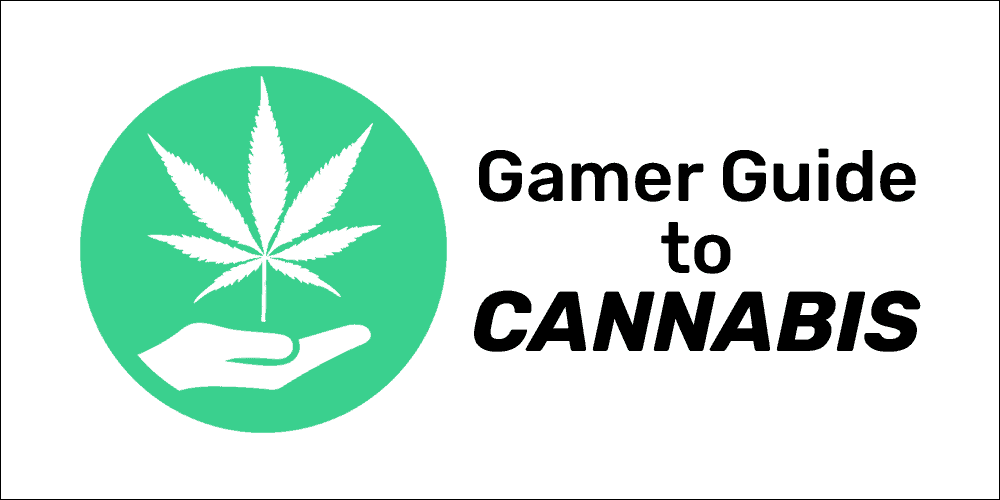
Key points
Disclaimer
This information is not intended to replace the advice of your doctor. Esports Healthcare disclaims any liability for the decisions you make based on this information as it does not establish, nor does it imply, doctor-patient relationship.
This is an educational post about cannabis sativa and includes information about marijuana, a Schedule I controlled substance in the United States of America. The statements regarding marijuana have not been evaluated by the Food and Drug Administration. This review is not intended to diagnose, treat, cure, or prevent any disease.
For United States residents, please review your state’s regulations on the legality of the purchase and use of hemp or marijuana products as many states have legal limitations. For non-US residents, please refer to your local and national regulations.
Cannabis has been a part of human culture for many millennia. Varying uses of the plant have been recognized in ancient Egypt, ancient China, and ancient Greece. And, despite many thousands of years of known use, many people still believe that cannabis is harmful or otherwise dangerous. According to available research, however, it is quite the opposite.
If you are one of those people still afraid of cannabis, I ask that you let down your guard to read this gamer guide to cannabis—an objective background of the plant and its molecules. And, if you are already in support of cannabis, then I hope you are able to learn something new.
Cannabis sativa
Cannabis sativa is the plant from which hemp and marijuana are cultivated. Beyond the more recent, infamous recreational drug history in the United States and other countries, the cannabis plant had been used for many thousands of years for items such as fiber (and therefore fabrics or rope), seed oil, and medicine.
However, throughout the 1800’s and 1900’s, many countries and territories throughout the world—including the United States in 1937—placed bans on the cultivation, distribution/sale, and use of cannabis, regardless of its purpose. The discussion of the politics behind the United States ban will be excluded for this discussion.
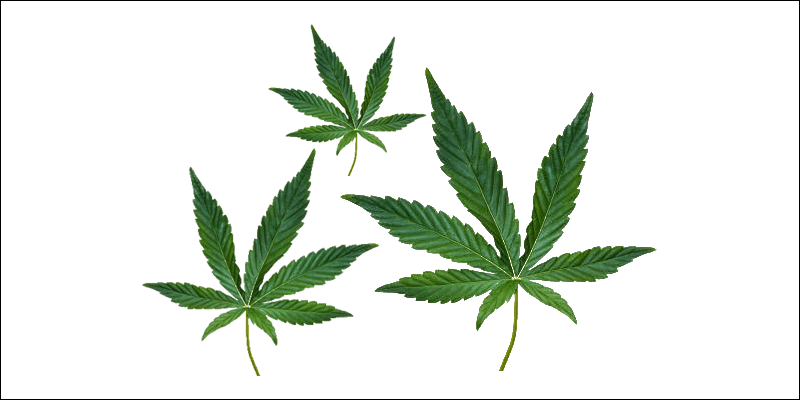
Hemp
In the United States, the Hemp Farming Act of 2018 federally legalized hemp as an agricultural commodity, allowing the growth, sale, and use of hemp nation-wide. By definition, hemp is the subgroup of cannabis that has less than 0.3% Δ9-tetrahydrocannabinol (THC), the chemical that causes intoxication or feeling high.
However, this federal legalization did not specifically include cannabidiol (CBD), and therefore, the legality of CBD is currently state regulated. As of January 2020, CBD is still completely illegal in Idaho, Iowa, and South Dakota. The other 47 states have legality with possible restrictions. For a list of legality and potential restrictions for your state, visit https://www.leafly.com/news/cbd/is-cbd-legal-state.
At <0.3% THC, using this plant for supplements, creams, tinctures, capsules (and more) will not cause the user to feel high or intoxicated the same way marijuana would. However, hemp is not only used for supplements and other health-related products. Hemp can also be used to make:
- Fiber with a tensile strength greater than that of steel
- A more bio-friendly plastic to replace petroleum-based plastics that pollute the earth
- “Hempcrete,” similar to concrete
- Clothing, fabric, rope, and paper
- In 1930, Henry Ford developed a car that was fueled by hemp oil instead of gasoline
Unfortunately, none of these products could be manufactured in the United States between 1937 and 2018 due to the total illegality of the cannabis plant. In today’s world, many of these products are taking a back seat for production due to the booming popularity and potential profitability of CBD products.
Marijuana
Marijuana is the subgroup of cannabis sativa that includes the chemical Δ9-tetrahydrocannabinol (THC). Perhaps most well-known for its psychoactive effects, THC is the portion of marijuana that causes intoxication or feeling high.
Currently, marijuana is illegal in the United States under federal law. Yet, many states have decriminalized the sale and recreational use of marijuana with many other states working on their own legislation.
However, the Controlled Substances Act still prohibits any and all use of marijuana in the United States. Therefore, the Food and Drug Administration (FDA) and National Institutes of Health (NIH) cannot support research, including any potential funding, for marijuana—even for medicinal purposes.
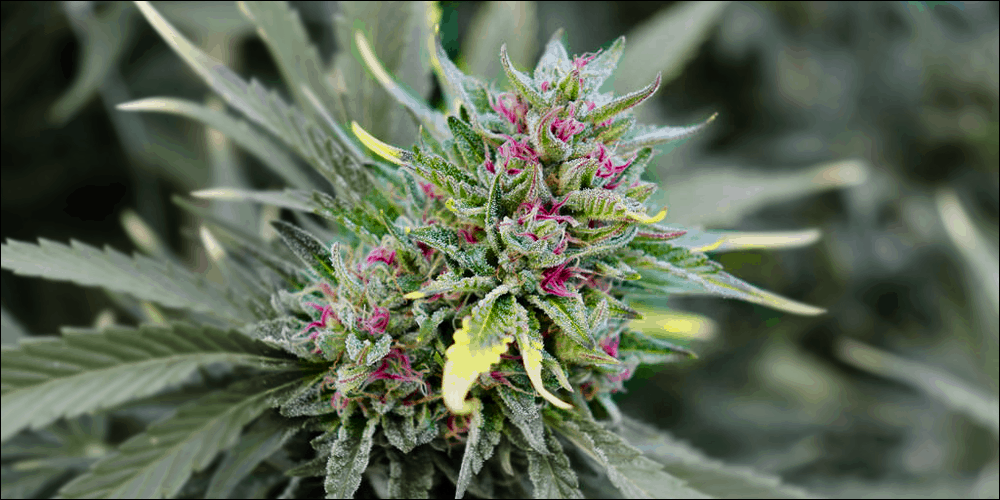
For recreational use of marijuana, fully legal states (and districts) include Alaska, California, Colorado, the District of Columbia, Illinois, Maine, Massachusetts, Michigan, Nevada, Oregon, Vermont, and Washington. In the 2020 elections, other states voted to approve legislation and will allow recreational use within the next couple years.
The endocannabinoid system
The endocannabinoid system (ECS) is present in nearly all organ systems of vertebrate creatures. The primary purpose of the ECS is to maintain the homeostasis—or balance for health and well-being—of all your cells and organ systems.
There are three components of the ECS:
- Cannabinoid receptors: trans-membrane proteins allowing binding of molecules on the outside of the cell to affect the atmosphere inside the cell
- Endocannabinoids: ligands to the cannabinoid receptors—think of a key to a lock—that stimulate a reaction in the ECS
- Metabolic enzymes: to breakdown the endocannabinoids after their use
Cannabinoid receptors
Currently, there are three known cannabinoid receptors. They are simply named CB1, CB2 and CB1a receptors. A forth receptor—GPR55—is also stimulated by cannabinoids, and it sometimes referred to in the literature as a CB3 receptor. In this discussion, we will only describe interactions with CB1 and CB2 receptors.
The majority of CB1 receptors are found within the brain and nerves in the peripheral nervous system. However, CB1 receptors can also be found in other peripheral tissues such as immune cells, adrenal glands, lungs, heart, bone marrow, thymus, tonsils, prostate, testis, uterus, and ovaries.
The majority of CB2 receptors are found in peripheral cells: immune cells, red bone marrow stem cells, keratinocytes, and peripheral nerve terminals. CB2 receptors are most well-known for their pain suppression, blocking nociception (the sensation of pain) when stimulated in nervous tissue. This pain suppression occurs most prominently in peripheral nervous system.
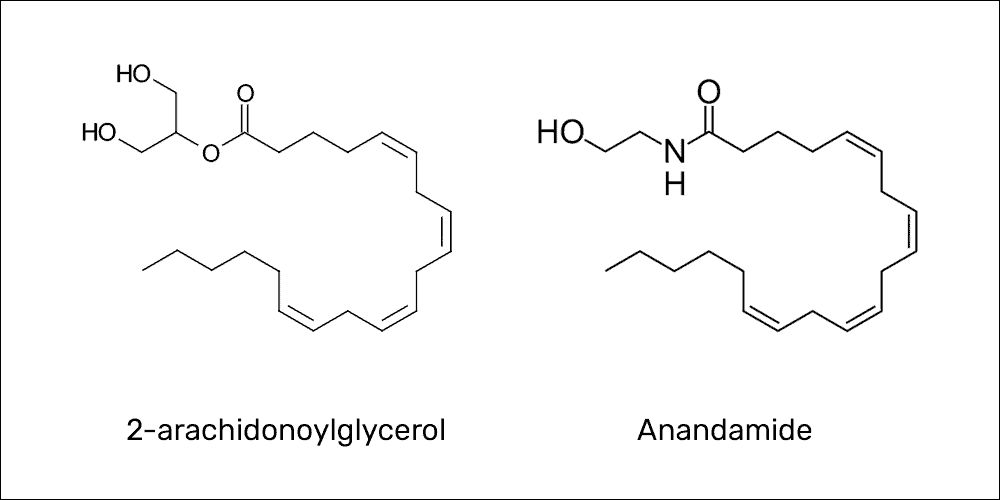
Endocannabinoids
Through research of cannabis, it was discovered that THC binds to two unique receptors, the CB1 and CB2 receptors named earlier. Following this discovery, researchers discovered two other molecules that bind directly to these receptors.
These molecules are produced within your body; in other words, they are endogenous. Thus, these endogenous molecules binding to the cannabinoid receptors were named endocannabinoids. The two currently known endocannabinoids are called anandamide and 2-arachidonoylglycerol (2-AG) and have an extraordinarily important role in regulating your body’s physiology.
How important is the ECS?
As previously mentioned, the ECS helps your body maintain homeostasis, or balance. Ultimately, the ECS mediates systemic health. To understand the vast importance of the ECS, here is a list of the organs or organ systems in which the ECS is present:
- Adipose (fat) tissue
- Blood cells
- Bone marrow
- Brain and nervous system
- Endocrine glands
- Gut (digestive system)
- Heart and cardiovascular system (blood vessels)
- Immune system
- Kidney
- Liver
- Lymphatic cells (immunity)
- Musculoskeletal system
- Skin
- Spleen
The ECS also helps regulate these body processes/functions:
- Appetite
- Energy and metabolism
- Inflammation
- Intraocular (eye) pressure
- Motivation and reward
- Muscle control (afferent nerve)
- Nociception (pain)
- Sensation (efferent nerve)
- Thermoregulation (body temperature)
Activation or enhancement of the ECS may also aid in prevention and/or treatment of these disorders/diseases:
- Chronic pain
- Diabetes
- Inflammatory conditions
- Arthritis
- Crohn’s disease
- Fibromyalgia
- Irritable bowel syndrome (IBS)
- Insomnia
- Mood and stress response
- Anxiety
- Stress
- Post-traumatic stress disorder (PTSD)
- Neurological disorders
- Epilepsy
- Multiple sclerosis (MS)
- Parkinson’s disease
- Dementia
- Traumatic brain injuries
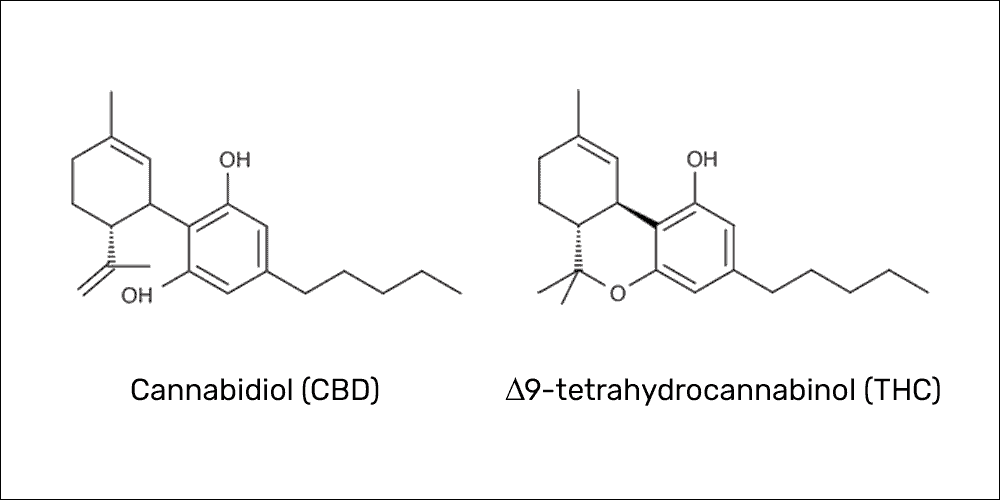
CBD and THC: the major players
There are many molecules found in cannabis—over 100 phytocannabinoids (phyto- means from plants) are currently known; however, the two that receive the most attention are cannabidiol (CBD) and Δ9-tetrahydrocannabinol (THC)—and rightfully so.
According to available research, these two molecules play the most active roles in human physiology by directly activating receptor cells or enhancing the molecules that are part of our endocannabinoid system (ECS).
Cannabidiol (CBD)
Cannabidiol, more commonly known by its abbreviation CBD, is the most researched molecule that comes from cannabis plant; although technically, CBD is not naturally occurring.
Instead, CBD is the byproduct of heat and time on the precursor molecule, cannabidiolic acid (CBDA) which occurs naturally in the cannabis plant. Following decarboxylation from the heating process, CBD—famous for its incredible health benefits—is produced.
CBD is highly active in the endocannabinoid system; however, it does not directly bind to the CB receptors described earlier. Instead, CBD enhances levels of anandamide—the endocannabinoid neurotransmitter of the brain—by inhibiting enzymes that break it down. CBD also interacts with and enhances other neurotransmitters including:
- Serotonin: most well-known for its positive affect on mood
- Dopamine: most well-known for the “reward pathway” in your brain
- Endogenous opioids: endorphins and other molecules that may improve mood or decrease pain
- GABA: an inhibitory neurotransmitter (decreasing nerve activity)
- Glutamate: the most abundant excitatory neurotransmitter (increasing nerve activity)
By enhancing anandamide and the above-listed neurotransmitters, CBD is heavily involved in maintaining homeostasis of both the central and peripheral nervous systems. Thus, CBD has been used as an effective pain modulator. CBD has also been used as a systemic anti-inflammatory, an antioxidant, to support immune function, and is largely neuroprotective.
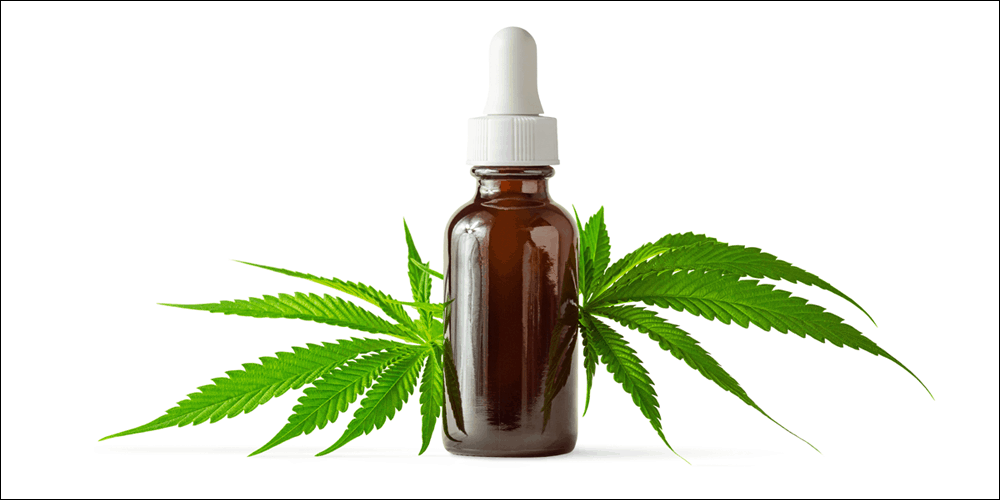
Δ9-tetrahydrocannabinol (THC)
Δ9-tetrahydrocannabinol, more commonly known by its abbreviation THC, is the molecule in cannabis that causes intoxication—the high feeling; although technically, THC is also not naturally occurring.
Instead, THC is the byproduct of heat and time on the precursor molecule, tetrahydrocannabinolic acid (THCA) which occurs naturally in the cannabis plant. Following decarboxylation from the heating process, THC is produced.
Similar to its counterpart in CBD, THC interacts with and enhances neurotransmitters such as acetyl choline, dopamine, GABA, glutamate, catacholamines, and endogenous opioids.
Unlike CBD, however, the THC molecule interacts directly with CB1 receptors in the brain because it mimics the endocannabinoid anandamide. Its direct binding to the CB1 receptor is what causes the psychoactive effects.
Additionally, THC binds with equal affinity to CB2 receptors. Thus, THC is acting on two major receptors of the endocannabinoid system and can affect many of the organs, organ systems, or processes listed above. Notably, THC has been shown to aid in the following:
- Analgesia (pain reduction)
- Anti-emetic (preventing vomiting)
- Anti-inflammatory, particularly in neural tissue
- Anti-nausea
- Anti-neoplasm (reducing cancer risk)
- Via apoptosis (programmed cell death) of cancer cells
- Antioxidant activity
- Appetite regulation
- Bronchodilation
- Decrease in intraocular pressure
- Mood elevation
- Muscle relaxation
- Neuroprotection
Uses in medicine
Cannabis has been used in medicine for many thousands of years. More recently, research has supported the use of THC, CBD, and other cannabinoids for many diseases and other ailments. On this page, the disease pathways, pathophysiology, or mechanism of action will not be discussed.
Cannabis—THC, CBD, and other cannabinoids, either alone or via their entourage effect—may be useful in the treatment or prevention of the following:
- AIDS/HIV and cachexia
- Alzheimer’s disease
- Amyotrophic lateral sclerosis (ALS)
- Asthma
- Cancer
- Chemotherapy-related nausea and vomiting
- Chronic pain
- Glaucoma
- Hepatitis/liver disease
- Huntington’s disease
- Inflammatory bowel disease
- Multiple sclerosis and myospasm
- Parkinson’s disease (PD)
- Psoriasis
- Skin tumors
- Sleep apnea
- Tourette’s syndrome
Many of the benefits noted in the available research for these diseases include the use of THC. However, it is important to reiterate that marijuana (not hemp), containing >0.3% THC, is currently listed as a Schedule I controlled substance. The FDA and NIH have not participated in any research on marijuana.
